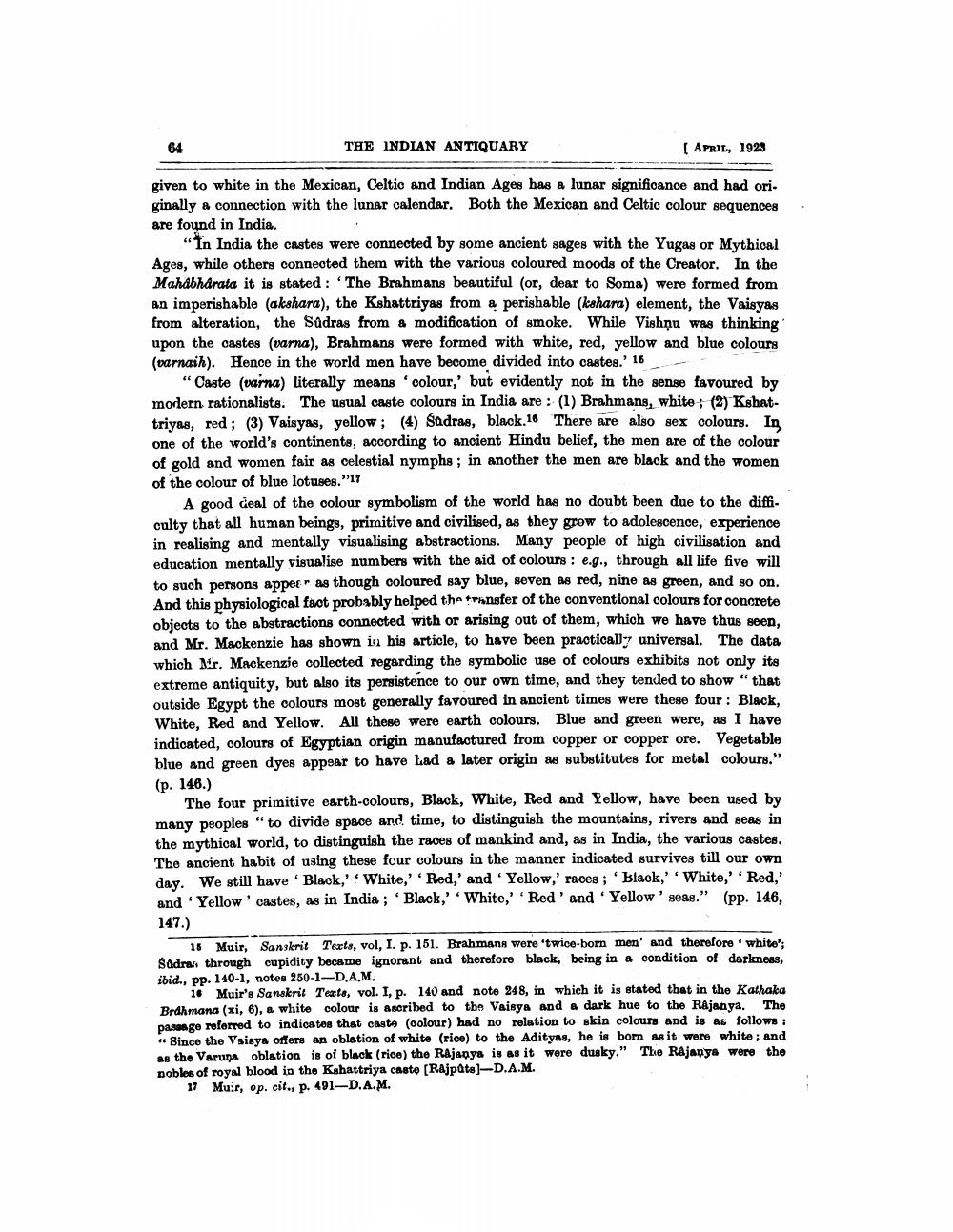________________
64
THE INDIAN ANTIQUARY
(APRIL, 1923
given to white in the Mexican, Celtic and Indian Ages has a lunar significance and had originally a connection with the lunar calendar. Both the Mexican and Celtic colour sequences are found in India.
"In India the castes were connected by some ancient sages with the Yugas or Mythical Ages, while others connected them with the various coloured moods of the Creator. In the Mahabharata it is stated : The Brahmans beautiful (or, dear to Soma) were formed from an imperishable (akshara), the Kshattriyas from a perishable (kshara) element, the Vaisyas from alteration, the Sadras from & modification of smoke. While Vishnu was thinking upon the castes (varna), Brahmans were formed with white, red, yellow and blue colours (varnaih). Hence in the world men have become divided into castes.' 16 -
"Caste (varna) literally means 'colour,' but evidently not in the sense favoured by modern rationalists. The usual caste colours in India are: (1) Brahmang, white ; (2) Kshattriyas, red; (3) Vaisyas, yellow; (4) Sadras, black.18 There are also sex colours. In one of the world's continents, according to ancient Hindu belief, the men are of the colour of gold and women fair as celestial nymphs ; in another the men are black and the women of the colour of blue lotuses."17
A good deal of the colour symbolism of the world has no doubt been due to the diffi. culty that all human beings, primitive and civilised, as they grow to adolescence, experience in realising and mentally visualising abstractions. Many people of high civilisation and education mentally visualise numbers with the aid of colours : e.g., through all life five will to such persons appear as though coloured say blue, seven as red, nine as green, and so on. And this physiological faot probably helped the transfer of the conventional colours for concrete objects to the abstractions connected with or arising out of them, which we have thus seen, and Mr. Mackenzie has shown in his article, to have been practically universal. The data which Mr. Mackenzie collected regarding the symbolic use of colours exhibits not only its extreme antiquity, but also its persistence to our own time, and they tended to show " that outside Egypt the colours most generally favoured in ancient times were these four: Black, White, Red and Yellow. All these were earth colours. Blue and green were, as I have indicated, colours of Egyptian origin manufactured from copper or copper ore. Vegetable blue and green dyes appear to have had a later origin as substitutes for metal colours." (p. 146.)
The four primitive earth-colours, Black, White, Red and Yellow, have been used by many peoples "to divide space and time, to distinguish the mountains, rivers and seas in the mythical world, to distinguish the races of mankind and, as in India, the various castes. The ancient habit of using these four colours in the manner indicated survives till our own day. We still have 'Black, White,' Red,' and 'Yellow,' races ; 'black,''White,' Red,' and Yellow 'castes, as in India ; Black, White,' Red' and 'Yellow' seas." (pp. 146, 147.)
18 Muir, Sanskrit Texts, vol, I. p. 151. Brahmans were 'twice-born ment and therefore 'white': Sadras through cupidity became ignorant and therefore black, being in a condition of darkness, ibid., pp. 140-1, notes 250-1-D.A.M.
16 Muir's Sanskrit Texte, vol. I, p. 140 and note 248, in which it is stated that in the Kathaka Brahmana (xi, 6), a white colour is ascribed to the Vaisya and a dark hue to the Rajanya. The pangngo referred to indicates that casta (colour) had no relation to skin colours and is as follows: 1. Since the Vsibye offers an oblation of white (rice) to the Adityas, he is born as it were white; and as the Varuna oblation is of black (rice) the Rajanya is as it were dusky." The Rajapye were the nobles of royal blood in the Kshattriya casto (Rajputs)-D.A.M.
17 Muir, op. cit., p. 491-D.A.M.




